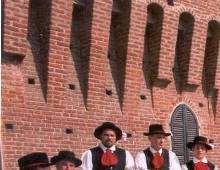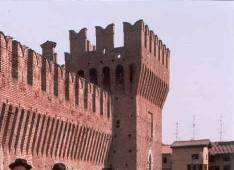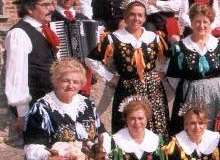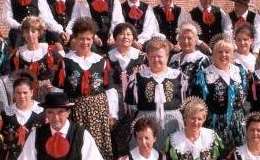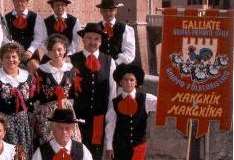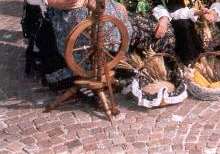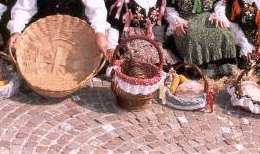
The group, counting 30/35 members, performs both in parade with exhibitions of dances and typical products
of Novara’s area and on stage showing original dances, regional characteristic sketches and songs of Piedmont.
The dances draw inspiration from local products like the “Gramulîn”, typical Galliate’s cake full of raisin
and covered with sugar grains and the “Baragiêu” a wine produced in the vineyards called “Baraggia”
on the rises located in the suburbs of Galliate, facing the Ticino’s valley; from female past labours and
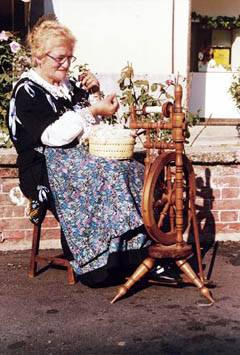 handworks like weaving “ A Bicòca e i firèlu “ ; from children’s game like the top “ A Pêrla” and moreover from
happiness events or tales of genial tricky people like “ Paradisu Nêuvu” and “L’umbrèla di Pidü” and the old strange
handed-on story of the cock of Galliate “ I Gà da Gajà” the symbol of our village.
handworks like weaving “ A Bicòca e i firèlu “ ; from children’s game like the top “ A Pêrla” and moreover from
happiness events or tales of genial tricky people like “ Paradisu Nêuvu” and “L’umbrèla di Pidü” and the old strange
handed-on story of the cock of Galliate “ I Gà da Gajà” the symbol of our village.
The performed sketches propose pictures of common popular life, like “ Catarinîn” the odd tale of a just-married
couple during their first night and “ Piänta piantà ‘nt i pra” a woodcutter’s nonsense rhyme.
The singing repertoire includes dialectal pieces from Galliate and popular Piedmonts songs.
The full repertoire supposes the taking part of the public in many occasions; the performance may last till two
hours or be only a nice and short participation.
The musical instruments are accordions, clarinets, trumpets, guitars and wooden lash integrated by a
microphone amplification system that allows to the group a full autonomy in every circumstance, even at night,
by developing the lighting, in the performing area, with two 1000 watt spot lamps.
|
I GA’ DA GAJÀ - Choreographic dance - Waltz
 ![]() The dance tells the story of a cock, Galliate's symbol and emblem.
People say that he was tired to stand on the town hall and so, one day,
it decided to go around the world looking for happiness. During its wandering,
it realized that the world was full of wickedness and troubles; it was so disappointed
that it decided to go back to its village. When it reached home, its happiness was so
big and it drank so much wine that it became a hen, it made an egg and it sat on it.
A chick was born, but it was already drunk!
The dance tells the story of a cock, Galliate's symbol and emblem.
People say that he was tired to stand on the town hall and so, one day,
it decided to go around the world looking for happiness. During its wandering,
it realized that the world was full of wickedness and troubles; it was so disappointed
that it decided to go back to its village. When it reached home, its happiness was so
big and it drank so much wine that it became a hen, it made an egg and it sat on it.
A chick was born, but it was already drunk!
|
A BICOCA L'È INGARBIÀ- The weaver's dance
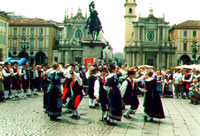
 ![]() A long time ago, one of the main jobs was spinning the cotton.
In every house there was the "firelu", the tool used for this work and all people
young or old people were able to use it.
The dance starts very slowly and regularly, recalling the economical crisis of
the weaving mills based in Galliate at the beginning of the nineteenth century,
then it speeds up gradually with a cheerful ending, meaning the work new recovery.
A long time ago, one of the main jobs was spinning the cotton.
In every house there was the "firelu", the tool used for this work and all people
young or old people were able to use it.
The dance starts very slowly and regularly, recalling the economical crisis of
the weaving mills based in Galliate at the beginning of the nineteenth century,
then it speeds up gradually with a cheerful ending, meaning the work new recovery.
|
LA MONFERRINA - Corrente - Running
 ![]() This is a very famous Italian dance and takes its origin in the
17th century, in Monferrato area, giving the name to the dance, too.
It belongs to the group of courtship dances and in the original version it is
included among the "currente" running dances. Thanks to the richness of jumps,
turns and twirls, this dance enable all the couples to show their ability.
This is a very famous Italian dance and takes its origin in the
17th century, in Monferrato area, giving the name to the dance, too.
It belongs to the group of courtship dances and in the original version it is
included among the "currente" running dances. Thanks to the richness of jumps,
turns and twirls, this dance enable all the couples to show their ability.
|
A L’UMBRELA DI PIDÜ - The dance of the umbrellas - Polka
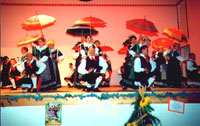
 ![]() This dance deals with a matter still actual nowadays: the housing problem.
A long time ago a group of jovial and cheerful people decided to find a solution and
they built up a very huge umbrella. It became their house and they were eating, drinking
and singing in happiness under this "roof", forgetting the problems of their life, at
least for a while.
This dance deals with a matter still actual nowadays: the housing problem.
A long time ago a group of jovial and cheerful people decided to find a solution and
they built up a very huge umbrella. It became their house and they were eating, drinking
and singing in happiness under this "roof", forgetting the problems of their life, at
least for a while.
|
IL CANTASTORIE - The story teller - Choreographic dance - Waltz
 ![]() This is the ballad of a story-teller, who came once to Galliate and
cheered up the people with his nice songs, wandering around roads and squares.
This is the ballad of a story-teller, who came once to Galliate and
cheered up the people with his nice songs, wandering around roads and squares.
|
VARDA A PÊRLA MÈ CA VÀ - The dance of the spinning top - Polka
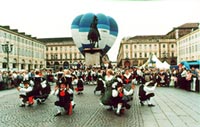
 ![]() The name "pêrla" means spinning but in Italian it may be a play on words,
not to be misunderstood. The top, together with the "lêpa" and the "scazû" was a healthy
amusement for the old generations. It was played almost everywhere, in squares and on roads.
It was enough to have a whip, a wooden cone and some imagination to spend some nice,
amusing hours. It was so important that Galliate decided to dedicate it a song and later
on even a dance.
The name "pêrla" means spinning but in Italian it may be a play on words,
not to be misunderstood. The top, together with the "lêpa" and the "scazû" was a healthy
amusement for the old generations. It was played almost everywhere, in squares and on roads.
It was enough to have a whip, a wooden cone and some imagination to spend some nice,
amusing hours. It was so important that Galliate decided to dedicate it a song and later
on even a dance.
|
MANGHÎN E MANGHINA DI GALLIATE - Waltz
 ![]() This is typical dance employed, because of its own feature, to introduce
the dancers to the public during performances. Happiness and cheerfulness are
so alluring and inviting in this dance that it has been chosen as good-wishing
dance for the opening ceremony of the International Folkloristic Festival,
taking place in Galliate every two years.
A couple of each folk group attending the meeting is then invited to perform
this beginning dance together with our group.
This is typical dance employed, because of its own feature, to introduce
the dancers to the public during performances. Happiness and cheerfulness are
so alluring and inviting in this dance that it has been chosen as good-wishing
dance for the opening ceremony of the International Folkloristic Festival,
taking place in Galliate every two years.
A couple of each folk group attending the meeting is then invited to perform
this beginning dance together with our group.
|
L’ARCA ‘D NUÈ- Galliate's wine dance - Waltz
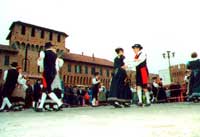
 ![]() Galliate has got its local wine-making. The "Baragiêu" is a red, less alcoholic
wine produced from American grapes, exalting its taste. A long time ago, this wine was
much diffused but it is still produced in small quantities. Although not world-wide known,
it is locally much appreciated and gives warmth and liveliness to any popular feasts.
The rhythm set in this dance is a sweet memory of the old wine-pressing, as it was a long
time ago, when grapes were crushed by feet
Galliate has got its local wine-making. The "Baragiêu" is a red, less alcoholic
wine produced from American grapes, exalting its taste. A long time ago, this wine was
much diffused but it is still produced in small quantities. Although not world-wide known,
it is locally much appreciated and gives warmth and liveliness to any popular feasts.
The rhythm set in this dance is a sweet memory of the old wine-pressing, as it was a long
time ago, when grapes were crushed by feet
|
The Ticino's waltz
 ![]() The Ticino River rises on Saint Gotthard in Switzerland, it forms the Maggiore
Lake and then it flows down running along our village, Galliate and, further on it joins
the Po river.
Many festivals are organized along its banks and this dance is just dedicated to the
Ticino River that, with its clear and fresh water makes Galliate a very important
Italian bathing-river resort.
The Ticino River rises on Saint Gotthard in Switzerland, it forms the Maggiore
Lake and then it flows down running along our village, Galliate and, further on it joins
the Po river.
Many festivals are organized along its banks and this dance is just dedicated to the
Ticino River that, with its clear and fresh water makes Galliate a very important
Italian bathing-river resort.
|
GAJÀ E I SO BUMBÒ - Galliate's cake waltz
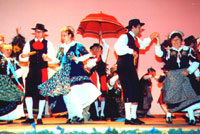
 ![]() This dance is dedicated to the typical cake baked in Galliate: the "Gramulîn".
This characteristic-shaped cookie is richly full of raisins and covered by a coating
of sugar grains.
Now it is a daily cake but, in past times, it was taken out from the oven only on Saint
Joseph's day, the patron and traditional holiday of Galliate.
This dance is dedicated to the typical cake baked in Galliate: the "Gramulîn".
This characteristic-shaped cookie is richly full of raisins and covered by a coating
of sugar grains.
Now it is a daily cake but, in past times, it was taken out from the oven only on Saint
Joseph's day, the patron and traditional holiday of Galliate.
|
VECCHIO PIEMONTE - Old Piedmont - Choreographic Polka

 ![]() From an old Piedmont's piece takes its origin this cheerful and lively dance.
A very quick rhythm allows the performance of very choreographic steps with many little
jumps and pirouettes while the dancers intertwine and exchange in different choreography
forming circles and stars. During the dance there aren't any fixed arranged couples,
but every dancer changes continuously the partner by developing different movements.
The good result of this dance is possible only with a perfect synchronism of all the
dancers, during this incessant alternating.
From an old Piedmont's piece takes its origin this cheerful and lively dance.
A very quick rhythm allows the performance of very choreographic steps with many little
jumps and pirouettes while the dancers intertwine and exchange in different choreography
forming circles and stars. During the dance there aren't any fixed arranged couples,
but every dancer changes continuously the partner by developing different movements.
The good result of this dance is possible only with a perfect synchronism of all the
dancers, during this incessant alternating.
|
LA SCOPA - The broom - Waltz
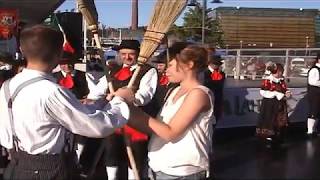 ![]() Till the middle of last century, during the summer months, many rice-pickers,
mostly young women from all Italy, worked in rice-fields. In the evening they all
gathered to dance on the threshing-floor. As many of those young girls and the local
young boys were shy, they thought out a trick to make friends and they used a broom,
as an ideal partner to be exchanged during the dances. Thanks to this non-stop exchanging
of ladies, they had the opportunity to know each other. The one, who held the broom, when
the music stopped, had to play a forfeit.
Till the middle of last century, during the summer months, many rice-pickers,
mostly young women from all Italy, worked in rice-fields. In the evening they all
gathered to dance on the threshing-floor. As many of those young girls and the local
young boys were shy, they thought out a trick to make friends and they used a broom,
as an ideal partner to be exchanged during the dances. Thanks to this non-stop exchanging
of ladies, they had the opportunity to know each other. The one, who held the broom, when
the music stopped, had to play a forfeit.
|
IL BALLO DEL CERCHIO - The dance of the circle - Quadrille
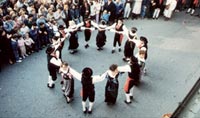
 ![]() This dance represents the fusion in a single circle of the southern
and northern folklore: actually the music coming from the South is merged with
the most characteristic dance from the North, exactly the circle.
This dance represents the fusion in a single circle of the southern
and northern folklore: actually the music coming from the South is merged with
the most characteristic dance from the North, exactly the circle.
|
TRINK, TRINK, BUDERLEIN, TRINK - Tyrolese Waltz
 ![]() In August 1985 the Folk Group " Manghin e Manghina" was present at the " First
World Festival of Folk dances " that took part in Münich.
In August 1985 the Folk Group " Manghin e Manghina" was present at the " First
World Festival of Folk dances " that took part in Münich.
During our stay, we had a pleasant and friendly relationship with an
Austrian group, with whom we sang, played and danced: the result of this nice twinning
is just this dance.
The learnt dance steps joined to a Tyrolese strong opera music are
now a sweet remembrance of that wonderful day.
|
LA QUADRIGLIA - The quadrille
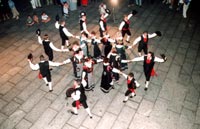
 ![]() The music is characteristic of Southern Italy; the dance is cheerful
and rich of turns, twirls and warmth: it looks really like its land of origin.
We dedicate it to all the people living among us but being away from home due to
work or family reasons.
The music is characteristic of Southern Italy; the dance is cheerful
and rich of turns, twirls and warmth: it looks really like its land of origin.
We dedicate it to all the people living among us but being away from home due to
work or family reasons.
|
THE JIG
 ![]() JIG can be considered as the most famous and the most ancient Irish song widespread
in Great Britain thanks to the migrations from the native island.
JIG can be considered as the most famous and the most ancient Irish song widespread
in Great Britain thanks to the migrations from the native island.
Since the beginning of 1900 jig was very popular in Novara area, and it is still danced in some part of the Piedmont.
It seems that these areas has been acquainted with jig thanks to some English mercenaries who crossed Sesia River
in May 1361 and lorded in these areas until 1363 thank to the German commander Albert Sterz. As soon as the mercenaries
were repelled from Piedmont to Tuscany thanks to Novarese troops, they were known for their several killings,
terrible brutality, dreadful destructions and also for the jig.
|
LA PIEMONTESINA - Song and sketch

 ![]() This song native of Turin is, since many years, part of the Italian popular
tradition and represents all Piedmont. It tells the story of two young students in
love but at the end of their studies they have to leave and they say goodbye to each
other keeping in their hearts the remembrance of their love.
This song native of Turin is, since many years, part of the Italian popular
tradition and represents all Piedmont. It tells the story of two young students in
love but at the end of their studies they have to leave and they say goodbye to each
other keeping in their hearts the remembrance of their love.
|
LA MARIOLÀ- Song
 ![]() This piece is sung in Piedmonts dialect and it tells about a man who
decided to get married. He hadn't got any fiancé so he started looking for an ideal
woman; in the text he describes the characteristics that the wife should have but, as
he cannot find such a woman, he decides that is better to enjoy life and to drink wine.
This piece is sung in Piedmonts dialect and it tells about a man who
decided to get married. He hadn't got any fiancé so he started looking for an ideal
woman; in the text he describes the characteristics that the wife should have but, as
he cannot find such a woman, he decides that is better to enjoy life and to drink wine.
|
LA RISAIA - Song
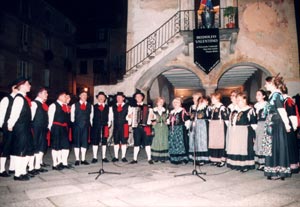
 ![]() A very typical song from lowlands of Novara and Vercelli, where the
rice production is also the primary culture and the main job was the rice-pickers (mondina).
Today this female work has been replaced by machines and modern equipments, but
the "mondina" still remains alive in everybody's mind and plays an important role
in our tradition.
A very typical song from lowlands of Novara and Vercelli, where the
rice production is also the primary culture and the main job was the rice-pickers (mondina).
Today this female work has been replaced by machines and modern equipments, but
the "mondina" still remains alive in everybody's mind and plays an important role
in our tradition.
|
LA CRICCA - The gang - Song
 ![]() This is a very famous song from Turin valleys. The protagonist of
this piece is a very happy gang of merry fellows, fond of mountain and good wine.
The main purpose of the gang is to forget sadness and life's problems by singing.
This is a very famous song from Turin valleys. The protagonist of
this piece is a very happy gang of merry fellows, fond of mountain and good wine.
The main purpose of the gang is to forget sadness and life's problems by singing.
|
CATARINÎN - Song and sketch

 ![]() This typical sketch of Galliate is the funny tale of a just-married
couple during their first night of marriage. Following past customs, the couple is
finally alone for the first time: the husband is very anxious and he immediately
goes to bed, but the wife, very shy and embarrassed finds thousand excuses not
to lie down until the new day arrives, without having satisfied her husband.
This typical sketch of Galliate is the funny tale of a just-married
couple during their first night of marriage. Following past customs, the couple is
finally alone for the first time: the husband is very anxious and he immediately
goes to bed, but the wife, very shy and embarrassed finds thousand excuses not
to lie down until the new day arrives, without having satisfied her husband.
|
I MATI DA GAJÀ - The girls form Galliate - Song and sketch
 ![]() This is a nice rigmarole of our town Galliate that is composed by many districts.
The song describes with irony the customs and the defects of the girls of each district.
This is a nice rigmarole of our town Galliate that is composed by many districts.
The song describes with irony the customs and the defects of the girls of each district.
|
IL MAGNANO - The Tinman - Song and sketch

 ![]() The tinman was very popular in Italy till the fifties. In the fixed days
of the month he arrived with his equipment and, by shouting, he invited to approach all
the women, who needed to repair a pot or other items. Usually he repaired immediately
everything but, when the damage was too bad, he took the pots home and brought them back
the next time. Normally everything was easy but sometimes the tinman had some love affairs.
The tinman was very popular in Italy till the fifties. In the fixed days
of the month he arrived with his equipment and, by shouting, he invited to approach all
the women, who needed to repair a pot or other items. Usually he repaired immediately
everything but, when the damage was too bad, he took the pots home and brought them back
the next time. Normally everything was easy but sometimes the tinman had some love affairs.
|
PIÄNTA PIANTÀ ‘NT’I PRA - Song and sketch
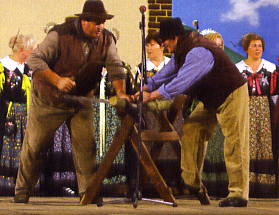
 ![]() This is a good example of iterative song in Gallite's dialect that in its tradition
enumerates some similar songs. This one, conceived by a wood-cutter , tells about a tree that
stand in a meadow and it was really unique with its trunk, branches, twigs and leaves ones
connected to the others and supporting a intertwined nest up, among the leaves.
This rigmarole is very easy but the text may last forever, it depends on the singer's
imagination: it seems that a wood-cutter sang enough to prepare many quintals of woods.
This is a good example of iterative song in Gallite's dialect that in its tradition
enumerates some similar songs. This one, conceived by a wood-cutter , tells about a tree that
stand in a meadow and it was really unique with its trunk, branches, twigs and leaves ones
connected to the others and supporting a intertwined nest up, among the leaves.
This rigmarole is very easy but the text may last forever, it depends on the singer's
imagination: it seems that a wood-cutter sang enough to prepare many quintals of woods.
|
L'ARROTINO - (‘l moulita) - The knife grinder - Song

 ![]() When the knife-grinder shouted " ' L moulita! 'l moulita! " all the women,
who had some scissors, knives of other items to be sharpened, surrounded him and waited for
their turn to be attended without pushing. As a matter of fact, the skilful handling of so
many blades commanded respect and the knife-grinder, moving from court to court, after having
shouted his arrival, worked in silence sharping everything excepting tongues, that were, as he
was always telling, already sharp.
The equipment was very simple. On a solid wooden support was based the grindstone, it
was clasped to some tools linked to a pedal and, as by magic, the foot alternative movement
up and down became a rotative motion. That's it! The song tells about a young boy, a
knife-grinder like is father. They both go around the world, their cosy world earning
some money. Their life is simple, approaching plain people, eating natural food and
drinking good wine.
Father and son with rubicund faces are the health portrait.
When the knife-grinder shouted " ' L moulita! 'l moulita! " all the women,
who had some scissors, knives of other items to be sharpened, surrounded him and waited for
their turn to be attended without pushing. As a matter of fact, the skilful handling of so
many blades commanded respect and the knife-grinder, moving from court to court, after having
shouted his arrival, worked in silence sharping everything excepting tongues, that were, as he
was always telling, already sharp.
The equipment was very simple. On a solid wooden support was based the grindstone, it
was clasped to some tools linked to a pedal and, as by magic, the foot alternative movement
up and down became a rotative motion. That's it! The song tells about a young boy, a
knife-grinder like is father. They both go around the world, their cosy world earning
some money. Their life is simple, approaching plain people, eating natural food and
drinking good wine.
Father and son with rubicund faces are the health portrait.
|
THE CARTERS WITH THE WHIPS - sketch
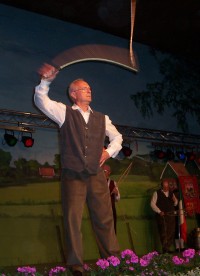
 ![]() Up to the middle of the past century, in Galliate, you could find the carters, that with their
chariots hauled by horses, transported the cloth from the mill, in the centre of town, to the
printing or wrapping factory, situated in the outskirts of town or in neighbouring villages.
Up to the middle of the past century, in Galliate, you could find the carters, that with their
chariots hauled by horses, transported the cloth from the mill, in the centre of town, to the
printing or wrapping factory, situated in the outskirts of town or in neighbouring villages.
To spur the horses they used the whips.
The precise recovery of this trade, by now all but disappeared with the advent of motor vehicles,
left us with the memory of the crack of the whips.
|
THE RANZA - Song and sketch
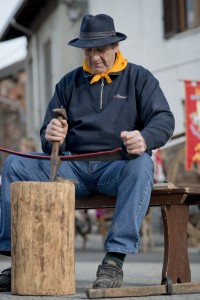 Ranza, an Italian word for "hay scythe", is a tool used for cutting hay, wheat and grass.
Nowadays only few people use it, as it has been substituted by mechanical tools of every dimension:
from the small lawnmower to the huge harvester.
Ranza, an Italian word for "hay scythe", is a tool used for cutting hay, wheat and grass.
Nowadays only few people use it, as it has been substituted by mechanical tools of every dimension:
from the small lawnmower to the huge harvester.
When everything was cut using our arms, the ranza was very important and
effective as long as the blade cuts properly and the blade thread holds together:
a whetstone could help to keep it sharp.
In order to restore the used blade thread, the ranza was put on a nail-shape
anvil sticked into a log or into the ground and then beaten by a little hammer.
This procedure required lots of technique: the blade was beaten from the widest
part to the top.
The wisest craftsmen sharpened them directly in the fields, and other one
sharpened them on the barnyard in the early morning, for the pleasure of the
neighbourhood participating to it and to the work that everybody will do
during the day.
During the show, the sharpening procedure is done according to the tradition
and along with the popular song “La Ranza”.
|
THE PICHER - Song and sketch
The indian corn, or maize, is a graminaceous plant originating from Central America, for a long time it has
been cultivated in north Italy where the inhabitants are called after the most famous food deriving from
the maize and are named “Polentoni”.
The maize needs a lot of works such as abundant manuring, hoeing and earthing up; nowadays the maize is
cultivated using big machinery during every working stage, some time ago the whole work was done by
hand and, after the harvesting, the corn-cobs in their corn-husk were piled up waiting to be husked, tied
up and hung on the railings of the cottages to dry.
Folk songs in all dialects of the Po valley are dedicated to maize and polenta. In particular a piedmontese
song tells the harvesting and maize-stripping work; this song explains then that, after the hara work, while
the polenta is cooking people warm themselves by the fire and love stories between daring boys
and beatiful girls originate.
|
IL BOCCALINO - Waltz
 ![]() This piece of Ticinese origin is performed by the group in the parades;
the dancers are in couple and show different steps of waltz. The slow and elegant
movements give a complete vision of the female and male costumes.
This piece of Ticinese origin is performed by the group in the parades;
the dancers are in couple and show different steps of waltz. The slow and elegant
movements give a complete vision of the female and male costumes.
|
LA MONFERRINA - Corrente - Running
 ![]() This is one of the most famous Italian musical pieces and takes its origin
in the 17th century, in Monferrato area, giving the name to the dance, too.
The group proposes it during the parades; thanks to the richness of jumps, turns
and twirls the execution of this dance is very quick and with a remarkable variety
of colours due to the constant movements of the dancers.
This is one of the most famous Italian musical pieces and takes its origin
in the 17th century, in Monferrato area, giving the name to the dance, too.
The group proposes it during the parades; thanks to the richness of jumps, turns
and twirls the execution of this dance is very quick and with a remarkable variety
of colours due to the constant movements of the dancers.
|
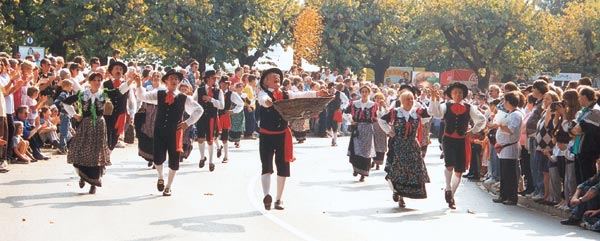
|
